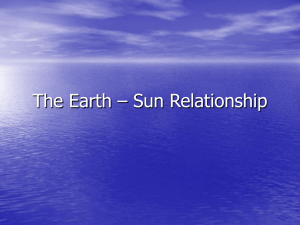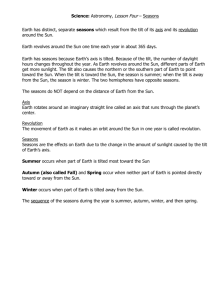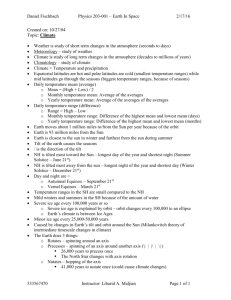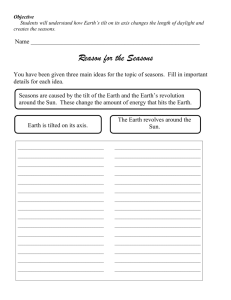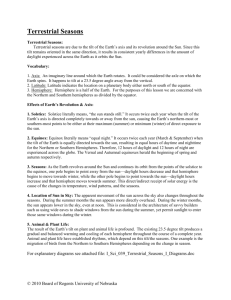Revolutionary Thoughts - Lesson
advertisement
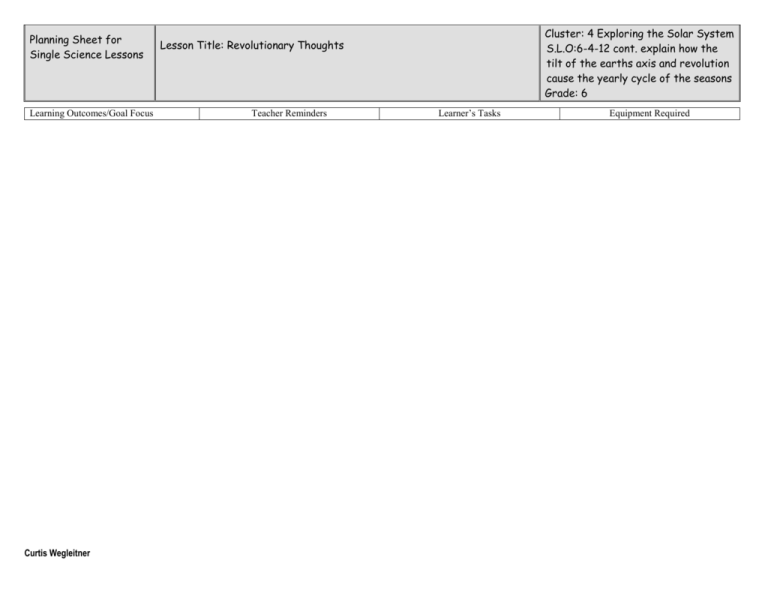
Planning Sheet for Single Science Lessons Learning Outcomes/Goal Focus Curtis Wegleitner Cluster: 4 Exploring the Solar System S.L.O:6-4-12 cont. explain how the tilt of the earths axis and revolution cause the yearly cycle of the seasons Grade: 6 Lesson Title: Revolutionary Thoughts Teacher Reminders Learner’s Tasks Equipment Required A. Scientific Inquiry/Nature of Science GLOA2 recognize that scientific knowledge is based on evidence, models and explanations, and evolves as new evidence appears and new conceptualizations develop Initiating, Researching & Planning Have a student read the story from last lesson aloud while the rest of the class focuses on/highlights parts of the story that address the earths axis and revolution of the earth and sun. Discuss earth’s axis and revolution with class. Ensure students have highlighted these points of the story. Implementing; Observing, Measuring & Recording 6-0-4C. Work cooperatively with group members to carry out a plan, and troubleshoot problems as they arise. GLO: C7 (ELA Grade 6, 5.2.2) Model rotation and revolution with globe and lamp (use appropriate terminology and vocabulary throughout and in context). Model and explain seasons. Begin with winter because it is currently winter. Ask why it is colder in the winter than the summer. 6-0-4D. Assume various roles to achieve group goals. GLO: C7 (ELA Grade 6, 5.2.2) Accentuate direct and indirect sunlight with the flashlight and point out how the shape of the beam of light changes shape at different points (latitude and longitude) on the globe. i.e. round near equator and oblong closer to the poles. Ask students why these are different and conclude that it is because one beam is hitting the globe directly and the other is hitting it indirectly. 6-0-5A. Make observations that are relevant to a specific question. GLO: A1, A2, C2 Analyzing & Interpreting Discuss and ask students the reasons for the seasons - similarities among and differences between them. Concluding & Applying Include tilt of axis, direct and indirect light/sunlight in discussion. 6-0-7B. Base conclusions on evidence rather than preconceived ideas or hunches. GLO: C2, C4 Curtis Wegleitner Big ball and flashlight for demonstration of light distribution Globes, nails, tape and flashlights or lamps for student groups either 15 or 8 depending on group size. Students highlight parts of story that address axis, tilt, revolution, seasons, etc. Questions to consider in your planning / delivery: 1. Does the lesson start through engagement? 2. Am I using this phase as an opportunity to find out where students are ‘at’ in their thinking? 3. Is there an emphasis on first-hand experiences – an evidential phase? 4. Am I helping students to make sense of these experiences – a psychological phase? 5. Is their a theoretical phase where the essential science knowledge is articulated and consolidated? 6. What specific skill and knowledge development am I emphasizing? Is there evidence of clear instructions and purposeful questions in my teaching sequence? Students use globes, nails, and sources of light to model revolution, explore how the earths tilt results in different amounts of direct sunlight at different times in the year. Students attach nails to globes at approximate Winnipeg location and position globe to noon (when Winnipeg is in line with the sun. i.e. in the middle of the lighted side of the globe.) students record information on the shadow including its length at various times in the year. Learning Outcomes/Goal Focus B. STSE Issues/ Design Process/ Decision Making C. Essential Science Knowledge Summary GLOD6 understand the composition of the universe, the interactions within it, and the impacts of humankind's continued attempts to understand and explore it E. Unifying Concepts GLOE2 describe and appreciate how the natural and constructed world is made up of systems and how interactions take place within and among these systems GLOE4 recognize that energy, whether transmitted or transformed, is the driving force of both movement and change, and is inherent within materials and in the interactions among them Teacher Reminders Ask students to explain why the shadow is different lengths at different times in the year. Prompt with tilt, axis, and orbit, direct, indirect light etc. Confirm and have students record a combination of the earths tilt and revolution are responsible for seasonal differences. This is because sunlight hits the earth more directly (straight on) and indirectly (on an angle) at different times of the year depending on which way the tilt is facing. i.e. less direct light during the winter results in the same amount of light over a greater area and vice versa in the summer. Equipment Required Students share reasons and discuss as a class. Questions to consider in your planning / delivery 7. How long will each phase last? 8. How am I going to organize working groups? 9. How will I organise and distribute equipment? 10. What specific skill and knowledge development am I emphasizing? 11. Is there evidence of clear instructions and Students record journals/note books. information in purposeful questions? 12. What must I look for in monitoring student Briefly touch on gravity as the reason for satellite orbits and mention that gravity, in the same way it keeps us (on earth) from flying off into space, the suns gravity keeps the Earth from coming out of orbit and heading out towards Pluto and beyond. Will you assess? If so, what? Students will be assessed on class and group participation, journal entries, and on final sketch of sun, earth, moon relationships, which will be revisited following several lessons on these topics. A few more activities/lesson/periods would be necessary to explore and build understanding of the difficult concepts in these two lessons. In providing various activities and sources of information (video computer models and simulations), students will have more opportunity to understand them. How will you assess it? Observational assessment will be via a checklist and sketches in journals will be an inventory assessment. Conceptual knowledge of these concepts will be verified through summative evaluation such as a test. This could be a good transition into lessons on the moon, the remaining planets and/or lesson on man made satellites. Have students draw Sun and Earth relationship again in journals/note books. Both of these sketches are for assessment (for and of). Curtis Wegleitner Learner’s Tasks learning? 13. How can I diversify instruction? Remind students how the scientific body of knowledge is continuously growing. Point out that this does not happen because of one individual, it happens in a way much like we have learned; people are continuously sharing information and knowledge, which is then built on by the rest of the scientific community. We used to think that the sun revolved around the earth but because of people like Copernicus who in 1543 theorized that the earth revolves around the sun, and Newton, who explained this by a theory of universal gravitation. Curtis Wegleitner


